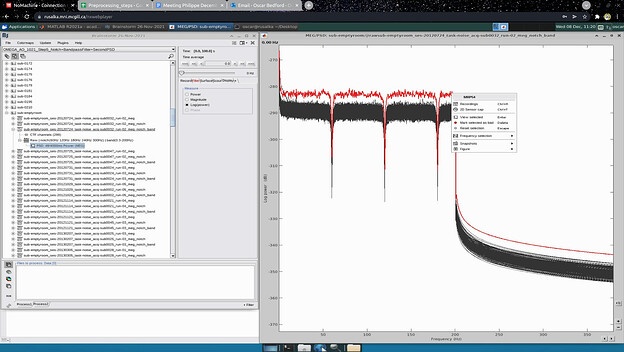Hi,
My colleague and I are currently doing some heavy duty pre-processing on a large sub-sample of the OMEGA dataset. We've run into three subjects who otherwise have good subject PSD plots post filtering (notch & bandpass) but whose noise PSD plots have at least one bad channel that seems off. When looking at the problematic channel/s, they seem to be following the general distribution of the subject PSD plot, so we're not sure if it's worth removing the channels altogether or not. Here's an example for subject 32, whose noise recording has a very detached MRP54:
What to do in such cases? More importantly, what is the criterion/criteria to decide when a channel in the noise is bad enough that it needs to be removed? Finally, just to confirm, do we need to remove the channel from both the noise channel AND the subject channel, or does it get removed from everywhere even if we only delete it from the noise channel?
Thanks,
Oscar
[quote="OscarBedford, post:1, topic:32254"]
When looking at the problematic channel/s, they seem to be following the general distribution of the subject PSD plot, so we're not sure if it's worth removing the channels altogether or not.
These channels have a noise level that is much higher than the other sensors.
You probably want to remove them for the source estimation.
More importantly, what is the criterion/criteria to decide when a channel in the noise is bad enough that it needs to be removed?
@Marc.Lalancette ?
Finally, just to confirm, do we need to remove the channel from both the noise channel AND the subject channel, or does it get removed from everywhere even if we only delete it from the noise channel?
Just mark the channels as bad in the continuous file for the subject session.
It does not matter if the noise covariance carries more information than needed. If the bad channels are excluded from the source estimation (this is something you can decided when computing the sources - you should have a window asking to confirm the indices of the channels to exclude), the corresponding rows/columns of the noise covariance matrix would simply not be used.
Hi Oscar,
First, you have around 275 sensors, so rejecting one is not a big deal. And in this example you show, the sensor is obviously misbehaving compared to all the others so it's fine to just reject it.
As a general rule however, the question is always whether keeping it will introduce more noise than signal and degrade or improve what you're trying to measure. So it depends on the sensor location vs ROIs, frequencies of interest, etc. and how strong the noise is vs the brain signals. First, I'd change the PSD display settings to log frequency or zoom in so you can better see the usual range of interest around 1-50 Hz. (I also prefer log of amplitudes in physical units for the y-axis because I know the CTF noise floor should be under 10 fT/sqrt(Hz).) Then compare this empty room vs one of your subject recordings. If the bad sensor is still well below the brain spectrum for this same sensor, then SNR is probably still ok and you could keep it.
Thanks @Francois & @Marc.Lalancette for your helpful answers! You can mark the thread as resolved if you want 

